Investigating the Effect of Repeated High Water Pressure on the Compressive and Bond Strength of Concrete with/without Steel Bar
Abstract
:1. Introduction
2. Experimental Program
2.1. Material Properties
2.2. Test Apparatus (Water Pressure Device)
2.3. Specimens and Testing Series
2.4. High-Water-Pressure Test Procedure
2.5. Processing after the High-Water-Pressure Test
3. Results and Discussions
3.1. Series I: Sustained High-Water-Pressure Test
3.2. Series II: Repeated High-Water-Pressure Test
3.3. Series III: The Internal Crack Condition of the Tested Specimen
3.4. Series IV: Pullout Strength of Tested Specimens
4. Conclusions
- The residual uniaxial compressive strength of concrete decreased immediately by 16% after 7 days of sustained high water pressure (60 MPa), but no surface cracks were observed. However, no further significant reduction in residual compressive strength was observed, as the period of sustained water pressure was extended to 60 days, although the formation of some surface pores was noted.
- The repeated application of high water pressure for 10 to 150 cycles caused inevitable damage to specimens as the propagation of surface cracks advanced. A significant reduction in residual uniaxial compressive strength reaching 40% was observed. Although all specimens exhibited a shear mode of failure in uniaxial compression tests, there was no further reduction in residual compressive strength after 60 loading–unloading cycles.
- The internal cracking state in specimens subjected to 60 and 150 cycles of high water pressure permitted a correlation with residual strength and surface cracking. The internal cracks were found to propagate within a certain damage zone as cracks within this weaker zone gradually joined as more cycles of loading were applied, leaving the core part of the cylindrical specimens in an uncracked state.
- Repeated cycles of high water pressure caused severe damage to concrete specimens with an embedded steel bar, as surface cracks propagated toward the steel bar and ultimately caused the loss of bond strength at the matrix/steel bar interface. This bond damage eventually led to a reduction of up to 36% in residual pullout capacity. In pullout tests, all specimens exhibited a splitting mode of failure.
- Bond damage in the reinforced specimens was examined by observing the condition of the concrete ribs at the interface between the matrix and steel bar after the pullout. Damage to the ribs intensified as the number of cycles increased. The result was a decrease in pullout stiffness and an increase in slippage of the steel bar from an early stage of loading.
- The detailed investigations of material properties such as permeability, porosity, SEM investigation, and long-term hydration effect on the concrete regarding the effect of repeated high water pressure are not considered in the current study. This information would be beneficial to reveal the deterioration mechanism in the future.
Author Contributions
Funding
Institutional Review Board Statement
Informed Consent Statement
Data Availability Statement
Conflicts of Interest
References
- Kato, Y.; Fujinaga, K.; Nakamura, K.; Takaya, Y.; Kitamura, K.; Ohta, J.; Toda, R.; Nakashima, T.; Iwamori, H. Deep-sea mud in the Pacific Ocean as a potential resource for rare-earth elements. Nat. Geosci. 2011, 4, 535–539. [Google Scholar] [CrossRef]
- Takaya, Y.; Yasukawa, K.; Kawasaki, T.; Fujinaga, K.; Ohta, J.; Usui, Y.; Nakamura, K.; Kimura, J.I.; Chang, Q.; Hamada, M.; et al. The tremendous potential of deep-sea mud as a source of rare-earth elements. Sci. Rep. 2018, 8, 5763. [Google Scholar] [CrossRef] [Green Version]
- Iijima, K.; Yasukawa, K.; Fujinaga, K.; Nakamura, K.; Machida, S.; Takaya, Y.; Ohta, J.; Haraguchi, S.; Nishio, Y.; Usui, Y.; et al. Discovery of extremely REY-rich mud in the western North Pacific Ocean. Geochem. J. 2016, 50, 557–573. [Google Scholar] [CrossRef] [Green Version]
- Fujinaga, K.; Yasukawa, K.; Nakamura, K.; Machida, S.; Takaya, Y.; Ohta, J.; Araki, S.; Liu, H.; Usami, R.; Maki, R.; et al. Geochemistry of REY-rich mud in the Japanese Exclusive Economic Zone around Minamitorishima Island. Geochem. J. 2016, 50, 575–590. [Google Scholar] [CrossRef] [Green Version]
- Somero, G.N. Adaptations to high hydrostatic pressure. Annu. Rev. Physiol. 1992, 54, 557–577. [Google Scholar] [CrossRef] [PubMed]
- Taylor, M.L.; Gwinnett, C.; Robinson, L.F.; Woodall, L.C. Plastic microfibre ingestion by deep-sea organisms. Sci. Rep. 2016, 6, 1–9. [Google Scholar] [CrossRef] [Green Version]
- Zhang, D.; Liu, X.; Huang, W.; Li, J.; Wang, C.; Zhang, D.; Zhang, C. Microplastic pollution in deep-sea sediments and organisms of the Western Pacific Ocean. Environ. Pollut. 2020, 25, 9113948. [Google Scholar] [CrossRef]
- Kaiser, D.; Kowalski, N.; Waniek, J.J. Effects of biofouling on the sinking behavior of microplastics. Environ. Res. Lett. 2017, 12, 124003. [Google Scholar] [CrossRef] [Green Version]
- Ingraffea, A.R. Case studies of simulation of fracture in concrete dams. Eng. Fract. Mech. 1990, 35, 553–564. [Google Scholar] [CrossRef]
- Xu, S.; Wang, J. Crack propagation in a concrete dam underwater pressure and determination of the double-k fracture parameters. Tumu Gongcheng Xuebao/China Civ. Eng. J. 2009, 42, 119–125. [Google Scholar]
- Zhu, X.; Pekau, O.A. Seismic behavior of concrete gravity dams with penetrated cracks and equivalent impact damping. Eng. Struct. 2007, 29, 336–345. [Google Scholar] [CrossRef]
- Wang, G.; Wang, Y.; Lu, W.; Zhou, C.; Chen, M.; Yan, P. XFEM based seismic potential failure mode analysis of concrete gravity dam water-foundation systems through incremental dynamic analysis. Eng. Struct. 2015, 98, 81–94. [Google Scholar] [CrossRef]
- Marshall, A.L. Behaviour of Plain Concrete. Mar. Concr. 1990, 156–158. [Google Scholar] [CrossRef]
- Funari, M.F.; Spadea, S.; Fabbrocino, F.; Luciano, R. A moving interface finite element formulation to predict dynamic edge debonding in FRP-Strengthened concrete beams in service conditions. Fibers 2020, 8, 42. [Google Scholar] [CrossRef]
- Rabinovitch, O. Cohesive interface modeling of debonding failure in FRP strengthened beams. J. Eng. Mech. ASCE 2008, 134, 578–588. [Google Scholar] [CrossRef]
- Han, T.; Yang, W.H.; Yang, Z.J.; Zhang, C.; Bo, D.L. Monitoring study of shaft lining concrete strain in freezing water-bearing soft rock during mine shaft construction period in west China. Procedia Eng. 2011, 26, 992–1000. [Google Scholar]
- Li, Z.L.; Du, S.L. Experimental study on mechanical properties of concrete due to high seepage pore water pressure. Eng. Mech. 2011, 28, 72–77. [Google Scholar]
- Haynes, H.H.; Highberg, R.S. Concrete properties at ocean depths. J. Waterw. Harb. Coast. Eng. Div. 1976, 102, 455–470. [Google Scholar]
- De Lange, J.I. Research into the Behaviour of Reinforced Concrete Prisms after 2 and 8 Years of Exposure in 5 and 100 m Deep North Seawater; Report MaTS-BK-V6/SMOZ XXVIII; Stichting Materiaalonderzoek in de Zee: Delft, The Netherlands, 1984. [Google Scholar]
- Cui, J.; Hao, H.; Shi, Y. Study of concrete damage mechanism under hydrostatic pressure by numerical simulations. Const. Build. Mater. 2018, 160, 440–449. [Google Scholar] [CrossRef] [Green Version]
- Karinski, Y.; Yankelevsky, D.; Zhutovsky, S.; Feldgun, V. Uniaxial confined compression tests of cementitious materials. Const. Build. Mater. 2017, 153, 247–260. [Google Scholar] [CrossRef]
- Wang, R.; Li, Y.; Li, Y.; Xu, F.; Li, X.; Fu, T. Influence of Water Pressure on the Mechanical Properties of Concrete after Freeze-Thaw Attack under Dynamic Triaxial Compression State. Adv. Mater. Sci. Eng. 2019, 2019, 8702324. [Google Scholar] [CrossRef] [Green Version]
- Wang, Q.; Liu, Y.; Peng, G. Effect of water pressure on mechanical behavior of concrete under dynamic compression state. Const. Build. Mater. 2016, 125, 501–509. [Google Scholar] [CrossRef]
- Cui, J.; Hao, H.; Shi, Y.; Li, X.; Du, K. Experimental study of concrete damage under high hydrostatic pressure. Cem. Concr. Res. 2017, 100, 140–152. [Google Scholar] [CrossRef]
- Xue, W.; Yao, Z.; Jing, W.; Song, H. Mechanical damage and failure behavior of shaft-lining concrete after exposure to high pore-water pressure. J. Mater. Civ. Eng. 2020, 32, 04019339. [Google Scholar] [CrossRef]
- Sfer, D.; Carol, I.; Gettu, R.; Etse, G. Study of the behavior of concrete under triaxial compression. J. Eng. Mech. 2002, 128, 156–163. [Google Scholar] [CrossRef]
- Van Der Wegen, G.; Bijen, J.; Van Selst, R. Behaviour of concrete affected by sea-water under high pressure. Mater. Struct. 1993, 26, 549–556. [Google Scholar] [CrossRef]
- Harris, D.W.; Mohorovic, C.E.; Dolen, T.P. Dynamic properties of mass concrete obtained from dam cores. ACI Mater. J. 2000, 97, 290–296. [Google Scholar]
- Bjerkeli, L.; Jensen, J.J.; Lenschow, R. Strain development and static compressive strength concrete exposed to water pressure loading. ACI Struct. J. 1993, 90, 310–315. [Google Scholar]
- Clayton, N. Effect of water pressure on concrete strength. In Proceedings of the Second International Conference on Concrete under Severe Conditions, Troms, Norway, 21–24 June 1998; pp. 978–987. [Google Scholar]
- Hu, W.H.; Peng, G.; Zou, S.B.; Liang, H. A comparative analysis of damage characteristics of concrete under natural and water-saturated states. China Rural Water Hydropower 2014, 393, 115–121. [Google Scholar]
- Zhou, J.; Zhao, X.; Nie, Y.; Tian, Y. Influence of high water pressure on static and dynamic compressive strength of concrete. Adv. Civ. Eng. 2020, 2020, 8814626. [Google Scholar]
- Poinard, C.; Malecot, Y.; Daudevile, L. Damage of concrete in a very high stress state: Experimental investigation. Mater. Struct. 2010, 43, 15–29. [Google Scholar] [CrossRef]
- Chen, Z.; Hu, Y.; Li, Q.; Sun, M.; Lu, P.; Liu, T. Behavior of concrete in water subjected to dynamic triaxial compression. J. Eng. Mech. 2010, 136, 379–389. [Google Scholar] [CrossRef]
- Rutland, C.A.; Wang, M.L. The effects of confinement of failure orientation in cementitious materials: Experimental observations. Cem. Concr. Compos. 1997, 19, 149–160. [Google Scholar] [CrossRef]
- Matsui, S. Effect of Water on Fatigue Strength of RC Slabs of Road Bridges under Moving Loads. Proc. Jpn. Concr. Inst. 1987, 9, 627–632. [Google Scholar]
- Roper, H.; Hetherington, G.B. Fatigue of Reinforced Concrete Beams in Air, Chloride Solution, and Sea Water. Int. Concr. Abstr. Portal 1982, 75, 307–330. [Google Scholar]
- Chijiwa, N.; Mai, H.T.; Iwanami, M.; Saito, T.; Yamaya, A.; Motegi, H.; Shinozaki, H. Rapid degradation of concrete anchorage performance by liquid water. J. Adv. Concr. Technol. 2015, 13, 449–464. [Google Scholar] [CrossRef]
- Matsumoto, K.; Yamaguchi, H.; Nagai, K. Fatigue pull-out failure of deformed bars in concrete under the effect of liquid water. Cem. Concr. Compos. 2018, 91, 198–208. [Google Scholar] [CrossRef]
- JSCE. Standard Specifications for Concrete Structures-2007, Dam Concrete; Japan Society of Civil Engineering: Tokyo, Japan, 2007. [Google Scholar]
- JSCE. Standard Specifications for Concrete Structures-2007, Materials and Construction; Japan Society of Civil Engineering: Tokyo, Japan, 2007. [Google Scholar]
- Hori, T.; Chijiwa, N.; Iwanami, M. A Fundamental Research on Fracture Behavior of Concrete Under High Water Pressure. Annu. J. Civ. Eng. Ocean 2015, 3, 179–184. [Google Scholar]
- Jiradilok, P.; Wang, Y.; Nagai, K.; Matsumoto, K. Development of discrete meso-scale bond model for corrosion damage at steel-concrete interface based on tests with/without concrete damage. Constr. Build. Mater. 2020, 236, 117615. [Google Scholar] [CrossRef]
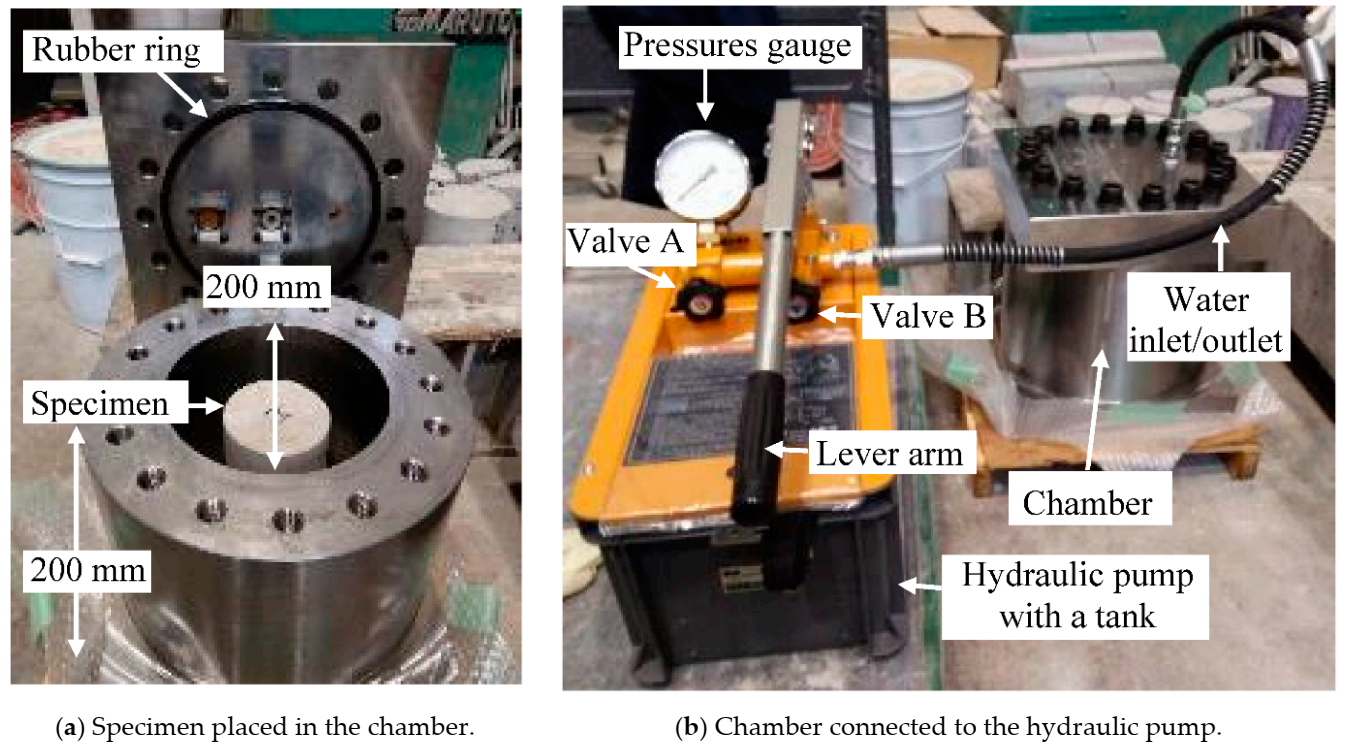


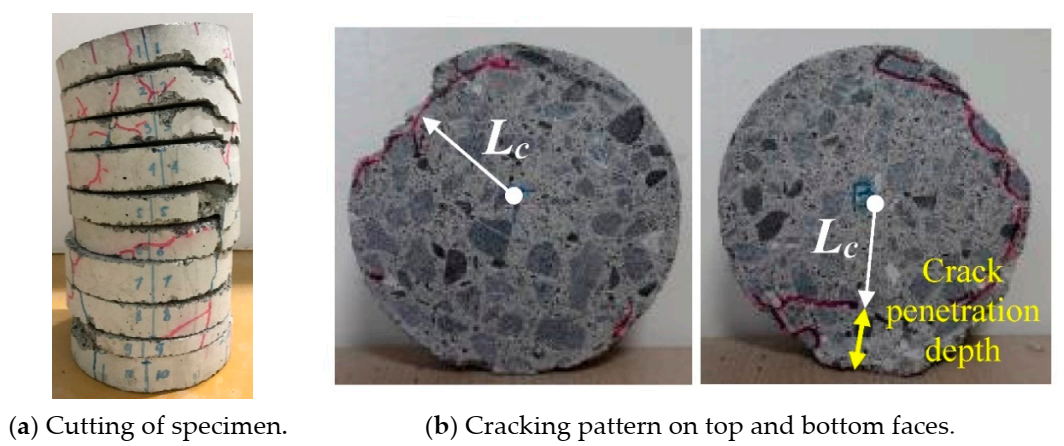

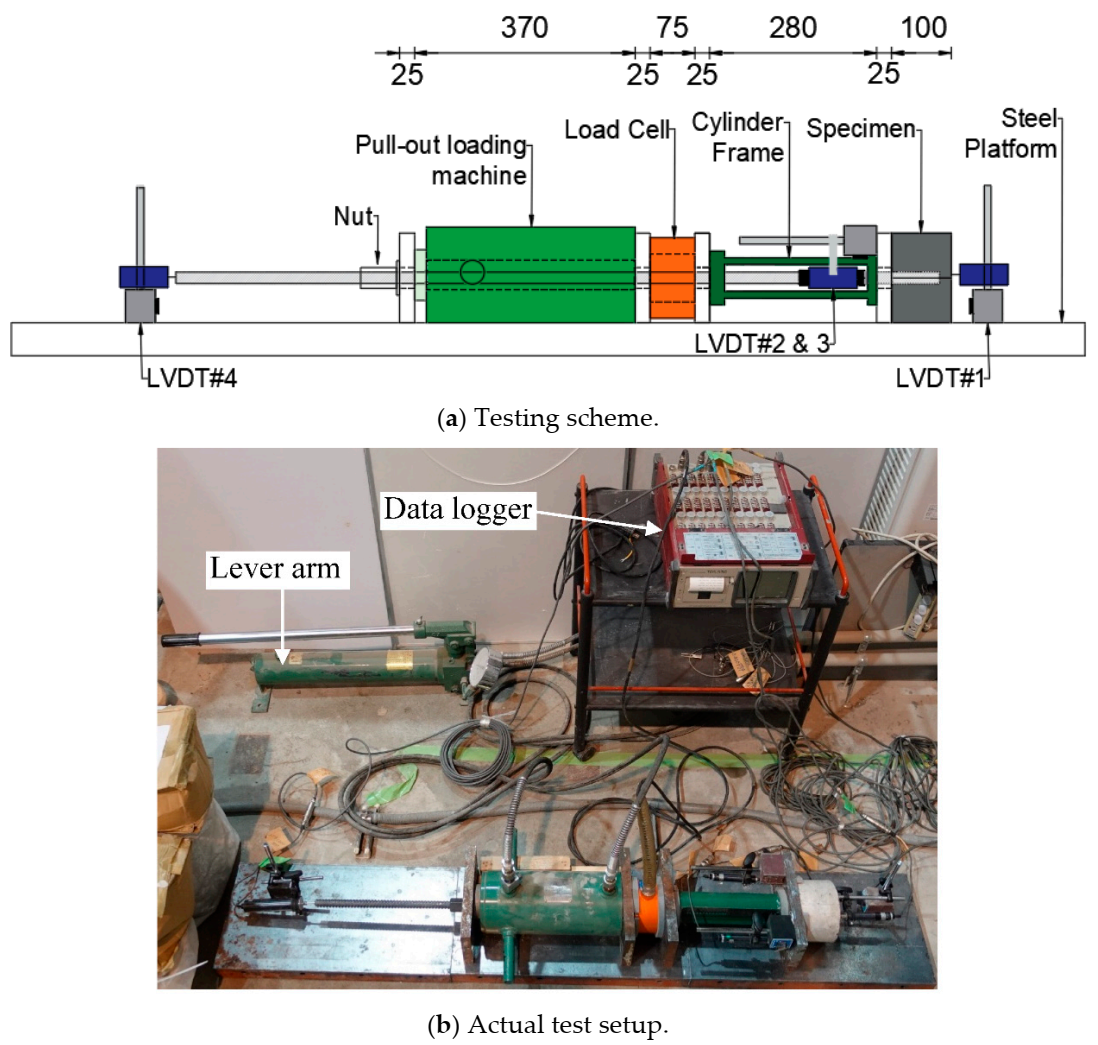
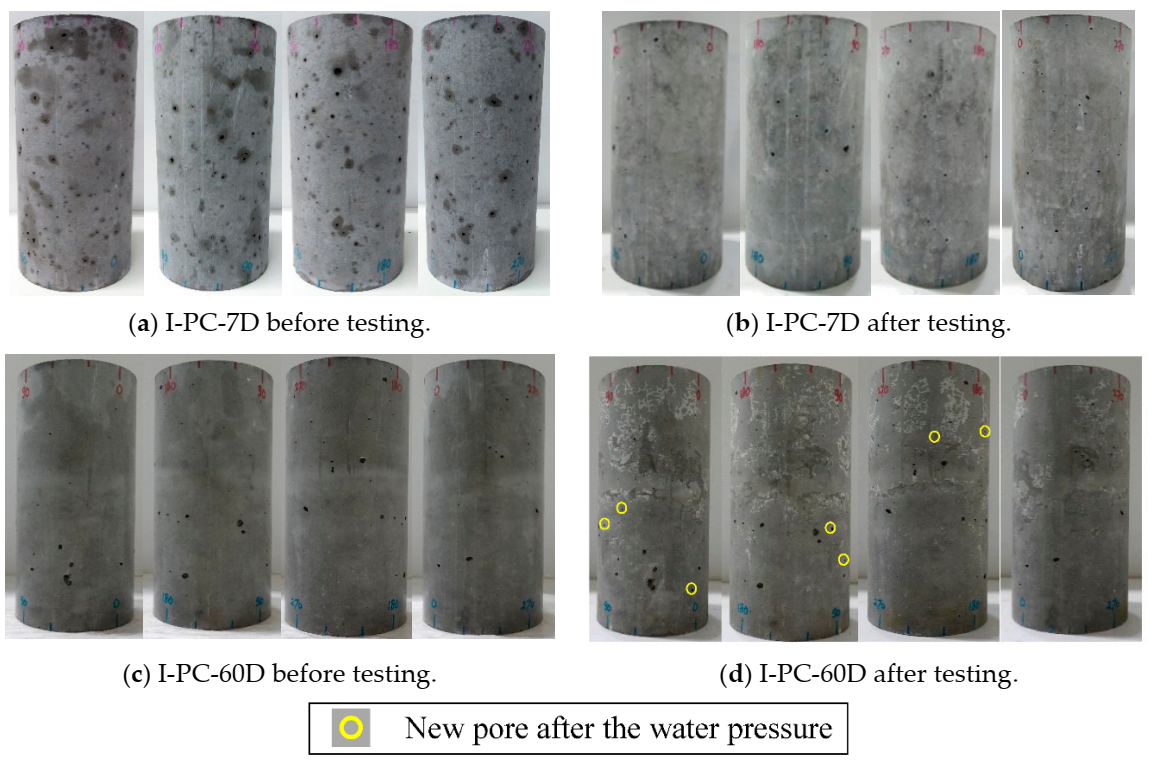
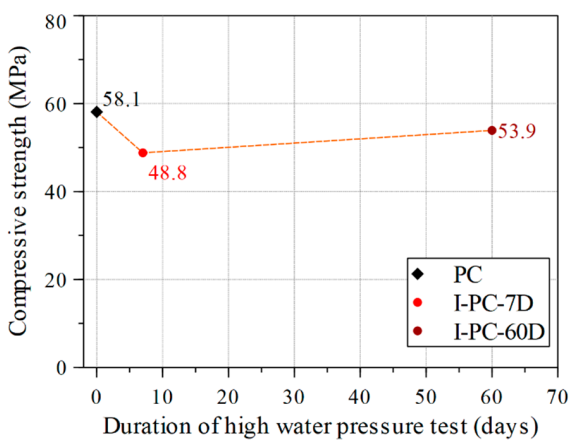
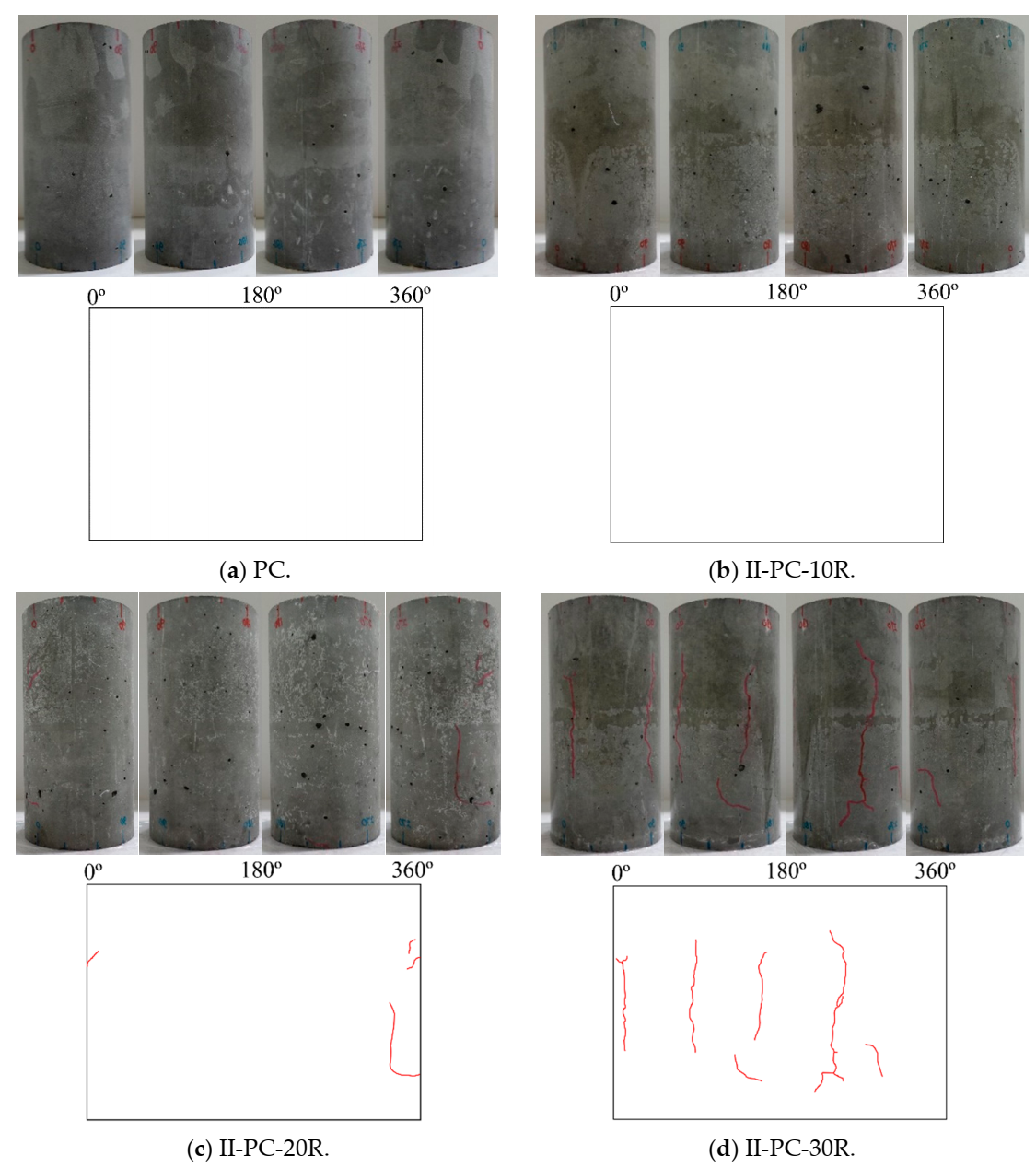
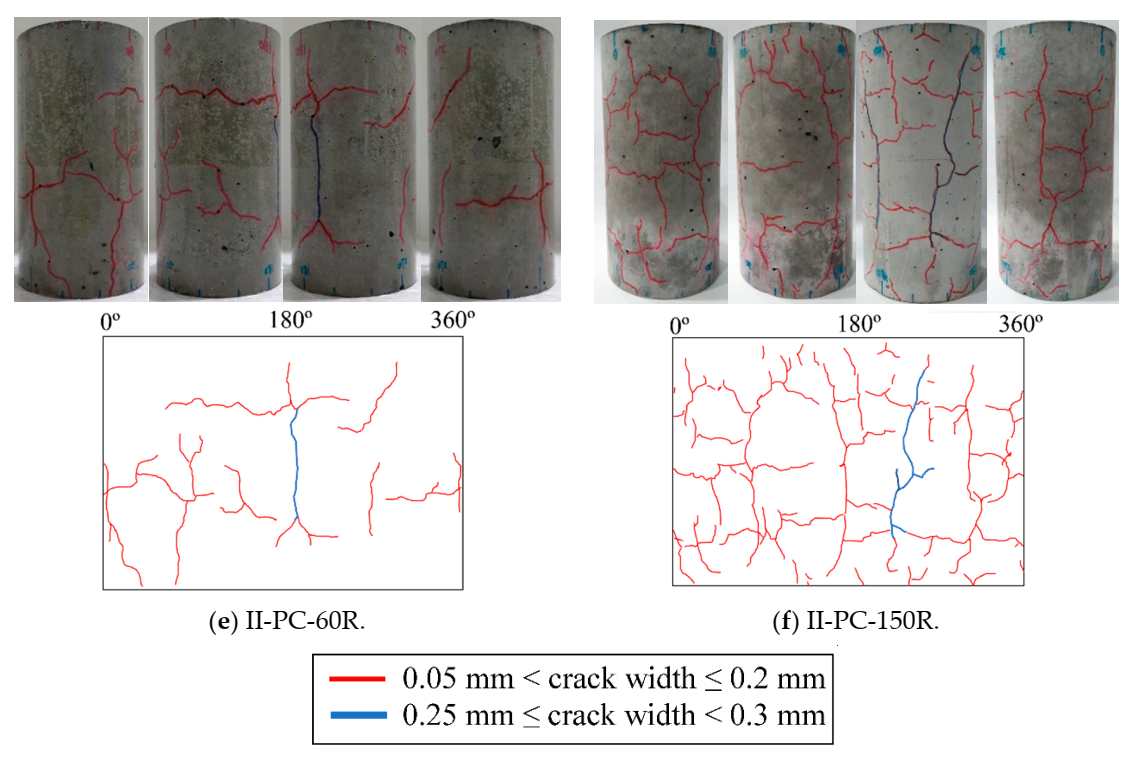





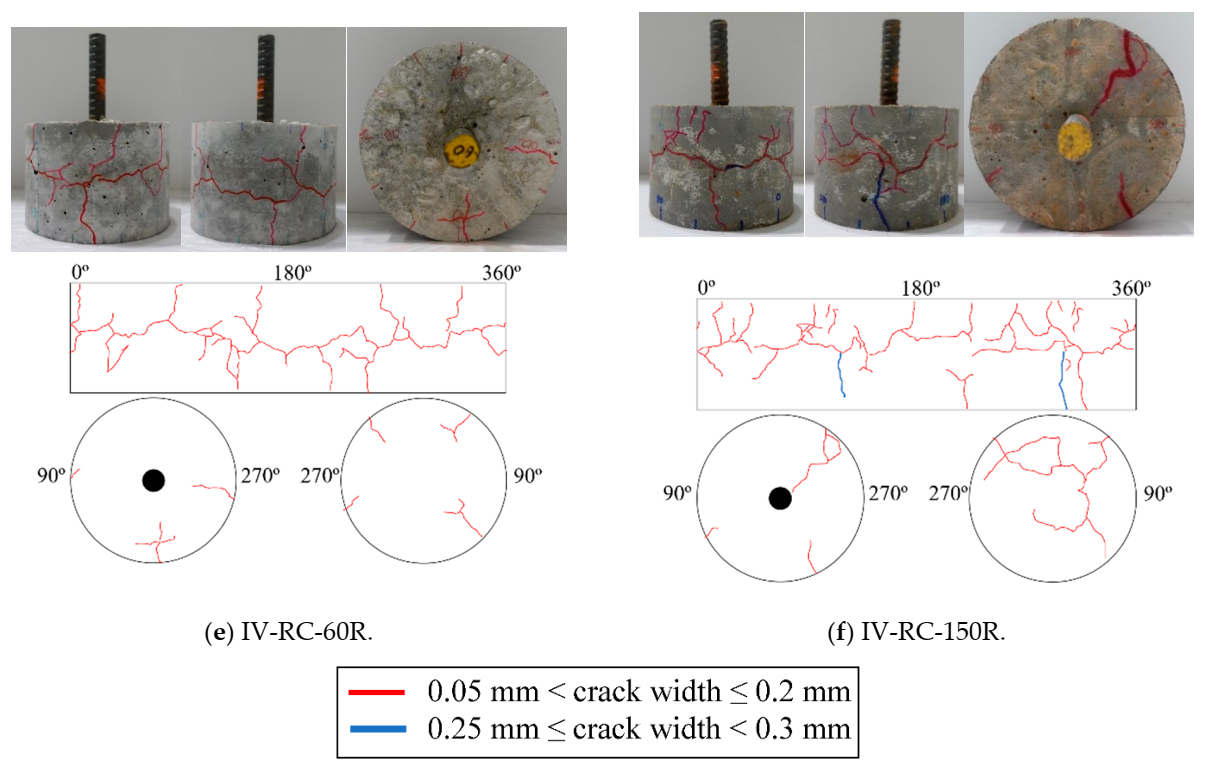
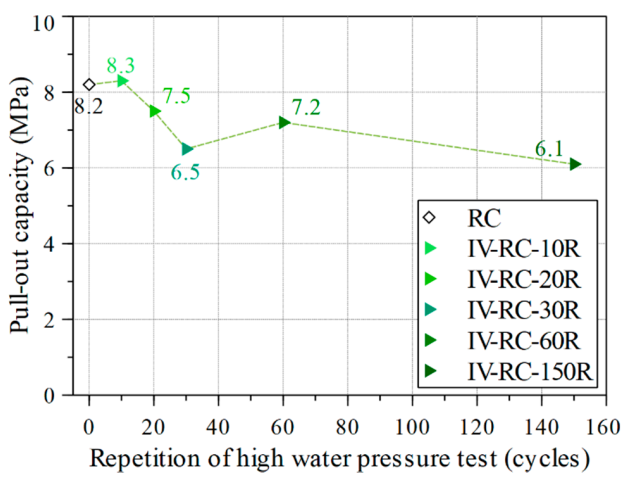
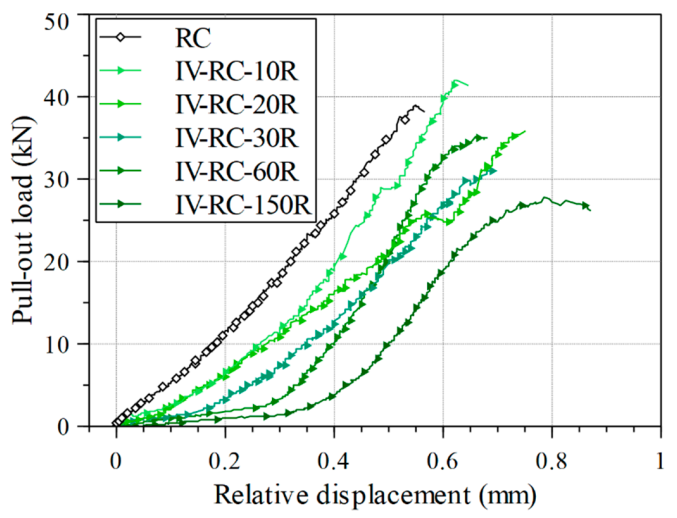


| Water (kg/m3) | Cement (kg/m3) | Sand (kg/m3) | Gravel (kg/m3) | SP (kg/m3) | Slump (mm) | Air Content (%) |
|---|---|---|---|---|---|---|
| 185 | 370 | 832 | 1021 | 0.2 | 100 | 3.0 |
| Type | Diameter (mm) | Area (mm2) | Weight(kg/m) | Yield Strength (MPa) | Modulus of Elasticity (GPa) |
|---|---|---|---|---|---|
| D19 | 19.1 | 286.5 | 2.25 | 420 | 190 |
| Series No. | Specimen ID | No. of Specimens | Specimen Layout | High-Water-Pressure Test | Post-Test Processing | |
|---|---|---|---|---|---|---|
| Testing Condition | Testing History | |||||
| - | PC | 3 | Concrete cylinder | Control | Uni-axial compression test | |
| I | I-PC-7D | 1 | Sustained | 7 days | ||
| I-PC-60D | 1 | 60 days | ||||
| II | II-PC-10R | 1 | Repeated | 10 cycles | ||
| II-PC-20R | 1 | 20 cycles | ||||
| II-PC-30R | 1 | 30 cycles | ||||
| II-PC-60R | 1 | 60 cycles | ||||
| II-PC-150R | 1 | 150 cycles | ||||
| III | III-PC-60R | 1 | 60 cycles | Cutting into ten slices in height | ||
| III-PC-150R | 1 | 150 cycles | ||||
| - | RC | 1 | Concrete cylinder with an embedded steel bar | Control | Pullout test | |
| IV | IV-RC-10R | 1 | Repeated | 10 cycles | ||
| IV-RC-20R | 1 | 20 cycles | ||||
| IV-RC-30R | 1 | 30 cycles | ||||
| IV-RC-60R | 1 | 60 cycles | ||||
| IV-RC-150R | 1 | 150 cycles | ||||
| Slice Number | III-PC-60R | III-PC-150R | ||
|---|---|---|---|---|
| Top | Bottom | Top | Bottom | |
| No.1 | - | 8 | - | 6 |
| No.2 | 8 | 10 | 15 | 13 |
| No.3 | 13 | 11 | 13 | 13 |
| No.4 | 13 | 13 | 16 | 16 |
| No.5 | 12 | 9 | 21 | 21 |
| No.6 | 15 | 15 | 18 | 25 |
| No.7 | 19 | 19 | 20 | 16 |
| No.8 | 21 | 25 | 15 | 15 |
| No.9 | 15 | 14 | 17 | 17 |
| No.10 | 8 | - | 14 | - |
Publisher’s Note: MDPI stays neutral with regard to jurisdictional claims in published maps and institutional affiliations. |
© 2021 by the authors. Licensee MDPI, Basel, Switzerland. This article is an open access article distributed under the terms and conditions of the Creative Commons Attribution (CC BY) license (http://creativecommons.org/licenses/by/4.0/).
Share and Cite
Muhaimin, A.A.; Adel, M.; Nagai, K. Investigating the Effect of Repeated High Water Pressure on the Compressive and Bond Strength of Concrete with/without Steel Bar. Materials 2021, 14, 527. https://doi.org/10.3390/ma14030527
Muhaimin AA, Adel M, Nagai K. Investigating the Effect of Repeated High Water Pressure on the Compressive and Bond Strength of Concrete with/without Steel Bar. Materials. 2021; 14(3):527. https://doi.org/10.3390/ma14030527
Chicago/Turabian StyleMuhaimin, Ahmad Aki, Mohamed Adel, and Kohei Nagai. 2021. "Investigating the Effect of Repeated High Water Pressure on the Compressive and Bond Strength of Concrete with/without Steel Bar" Materials 14, no. 3: 527. https://doi.org/10.3390/ma14030527
APA StyleMuhaimin, A. A., Adel, M., & Nagai, K. (2021). Investigating the Effect of Repeated High Water Pressure on the Compressive and Bond Strength of Concrete with/without Steel Bar. Materials, 14(3), 527. https://doi.org/10.3390/ma14030527







